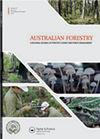Scaling of estimated breeding values for stand productivity in the Australian Pinus radiata breeding program
IF 0.9
4区 农林科学
Q3 FORESTRY
引用次数: 0
Abstract
ABSTRACT The radiata pine tree improvement program in Australia estimates breeding values for selection criteria traits (SCTs) such as diameter at breast height and height, as measured in progeny trials. The data in each trial are standardised so that estimated breeding values (EBVs) are expressed in units of additive genetic standard deviations. EBVs for harvest-age breeding objective traits (BOTs), such as stand volume mean annual increment (VMAI), are predicted from the SCT EBVs and expressed in measurement units. BOTs are not routinely measured in progeny trials because it would prolong the generation interval. However, the slope of the relationship between VMAI and BOT EBV provides an estimate of the scale of VMAI EBVs. This slope was estimated using 26 block-plot realised-gain trials with stand total produced basal area (TPBA) measurements near age ten years and 11 trials with final VMAI measurements between 15 and 25 years extrapolated to a harvest age of 25. In all trials, EBVs were positively correlated with growth, demonstrating substantial realised genetic gains. At age ten years, on average, one standard deviation of BOT EBV corresponded to a realised gain in TPBA of 3.7 m2 ha−1 and an additive coefficient of variation (CVA) of 11.2%. At the harvest age of 25 years, one standard deviation in EBV corresponded on average to realised gains in VMAI of 4.2 m3 ha−1 y−1 and a CVA of 15.0%. Methods for incorporating estimated genetic gains into growth and yield modelling and forest valuations are discussed.澳大利亚辐射松育种计划中林分生产力估计育种值的标度
摘要澳大利亚的辐射松改良计划估计了选择标准性状(SCT)的育种值,如在后代试验中测量的乳高和身高处的直径。每个试验中的数据都是标准化的,因此估计的育种值(EBV)以加性遗传标准差为单位表示。收获年龄育种目标性状(BOTs)的EBV,如林分体积年均增量(VMAI),是根据SCT EBV预测的,并以测量单位表示。在后代试验中没有常规测量BOT,因为它会延长世代间隔。然而,VMAI和BOT EBV之间关系的斜率提供了对VMAI EBV规模的估计。该斜率是使用26个块图实现的增益试验估计的,其中林分总产基底面积(TPBA)测量值接近10岁,11个试验的最终VMAI测量值在15至25岁之间,外推到25岁的收获年龄。在所有试验中,EBV与生长呈正相关,显示出显著的遗传增益。在10岁时,平均而言,BOT EBV的一个标准偏差对应于TPBA的实现增益3.7 m2 ha−1和11.2%的加性变异系数(CVA)。在25岁的收获年龄,EBV的一个标准偏差平均对应于4.2 m3 ha−1 y−1的VMAI实现收益和15.0%的CVA。讨论了将估计的遗传收益纳入生长和产量建模以及森林估价的方法。
本文章由计算机程序翻译,如有差异,请以英文原文为准。
求助全文
约1分钟内获得全文
求助全文
来源期刊

Australian Forestry
FORESTRY-
CiteScore
3.70
自引率
4.80%
发文量
15
审稿时长
>12 weeks
期刊介绍:
Australian Forestry is published by Taylor & Francis for the Institute of Foresters of Australia (IFA) for scientific, technical, and professional communication relating to forestry in the Asia Pacific.
 求助内容:
求助内容: 应助结果提醒方式:
应助结果提醒方式:


